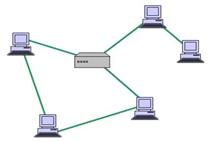Classifications of networks based on the topology
Network Topology is the schematic description how the arrangement of the network is including the nodes, connecting lines, and other devices. As per the above Table 7, the main network topologies are listed below.
- Bus
- Star
- Ring
- Mesh
- Tree/Hierarchical
Deep discussions on the topologies are beyond the level of this course unit. However, brief descriptions on each topology and images of them are given below.
Bus Topology
Bus networks (not to be confused with the system bus of a computer) use a common backbone to connect all devices. A single cable, the backbone, functions as a shared communication medium that devices attach or tap into with an interface connector. A device wanting to communicate with another device on the network sends a broadcast message onto the wire that all other devices see, but only the intended recipient actually accepts and processes the message.

Figure 16- Bus topology
Star Topology
Many home networks use the star topology. A star network features a central connection point called a "hub node" that may be a network hub, switch or router. Devices typically connect to the hub with Unshielded Twisted Pair (UTP) Ethernet.
Compared to the bus topology, a star network generally requires more cable, but a failure in any star network cable will only take down one computer's network access and not the entire LAN. (If the hub fails, however the entire network also fails.)
Ring Topology
In a ring network, every device has exactly two neighbors for communication purposes. All messages travel through a ring in the same direction (either "clockwise" or "counterclockwise"). A failure in any cable or device breaks the loop and can take down the entire network.

Figure 17- Star topology

Figure 18- Ring topology
To implement a ring network, one typically uses FDDI, SONET, or Token Ring technology. Ring topologies are found in some office buildings or school campuses.
Mesh Topology
Mesh topologies involve the concept of routes. Unlike each of the previous topologies, messages sent on a mesh network can take any of several possible paths from source to destination. (Recall that even in a ring, although two cable paths exist, messages can only travel in one direction.) Some WANs, most notably the Internet, employ mesh routing.
A mesh network in which every device connects to every other is called a full mesh. As shown in the illustration below, partial mesh networks also exist in which some devices connect only indirectly to others.

Figure 19- Mesh topology
Tree Topology
Tree topologies integrate multiple star topologies together onto a bus. In its simplest form, only hub devices connect directly to the tree bus and each hub functions as the root of a tree of devices. This bus/star hybrid approach supports future expandability of the network much better than a bus (limited in the number of devices due to the broadcast traffic it generates) or a star (limited by the number of hub connection points) alone.

Figure 20- Tree topology
The Internet
As you are already aware, the Internet is the largest WAN in existence (See Figure 21 below). It is a network of networks that consists of millions of private, public, academic, business, and government networks, of local to global scope, that are linked by a broad array of electronic, wireless and optical networking technologies. The Internet carries an extensive range of information resources and services, such as the inter-linked hypertext documents of the World Wide Web (WWW) and the infrastructure to support email.
With the dramatic rise in demand for connectivity, the Internet has become a communications highway for millions of users. The Internet was initially restricted to military and academic institutions, but now it is a full-fledged conduit for any and all forms of information and commerce. Internet websites now provide personal, educational, political and economic resources to every corner of the planet.

Figure 21- Internet: the largest WAN in existence
Дата добавления: 2017-05-18; просмотров: 2371;
